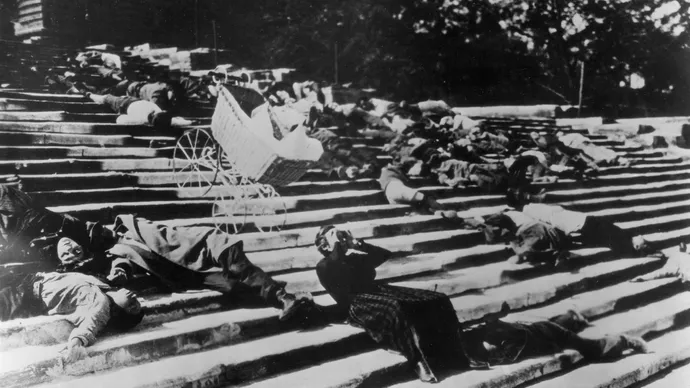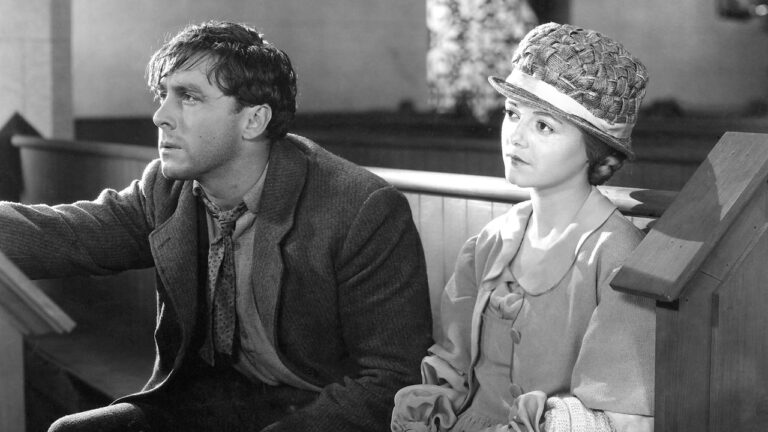Odessa, Odessa! How spirited must you be? Millions pour through your streets to reach your pier. Packeted together like shrimps, your frosty tendons froth with rage over the body of a dead and dear comrade. One begins to wonder whether the nation in its entirety has been summoned – so grandiose is Eisenstein’s intent. Chosen by Lenin himself to be displayed as a show of vigorous disobedience, Potemkin is an ideal representative of the scale that I’ve often admired in Russia, both in the literary sphere (Tolstoy’s War and Peace) and in the visual sphere (Tarkovsky’s Andrei Rublev). But how does Eisenstein communicate this scale – in a way, the first to successfully do so – and what makes Battleship Potemkin transcend the paltry title of propaganda?
Bluntly, Battleship Potemkin is an extension of theatre. One evinces this the most through its five-act structure. It begins with the tale of ‘Men and Maggots’ and ends with a dénouement that catches the red hand rising in unison. As a modern viewer, its plot points may not be hugely impressive, but even the uninformed viewer of the past would have thought the same given its theatrical bearings. What is then the difference in perception between the modern and pre-modern viewer is the forceful immutability of an image; it’s locked in, tightened from all sides, and as a result, removed from the pleasant and unpleasant surprises of live performance. The landscape too – especially in silent pictures – adds a dimension to an image that theatre couldn’t and hence endows it with a shade of meaning. 100 years down the road, we are now acutely aware of this. Moreover, there is a more rapid temporal transition – two images stitched together, each with separate backdrops, acquire shades of meaning faster than in theatre. We are now aware of this too. However, what makes Battleship Potemkin a formidable watch, then and now, is Eisenstein’s conscious and prescient exploitation of these parameters. Except, our current amazement must have been manifold for those who first witnessed it.
Images, be it with rocks, paper, or sensors as their canvas, have been seminal since the birth of civilization. In relation to imagery, I’ve always found the question, “Why do I gravitate towards cinema?” difficult to answer, but I shall try expanding on it here. An impossible cogitation, but I can only look at this two ways. Firstly, the act of being outside oneself. “Between the wolf in the tall grass and the wolf in the tall story there is a shimmering go-between,” Nabokov notes about a Neanderthal boy’s apocryphal tale of a wolf at his heels. “That go-between, that prism, is the art of literature,” is his conclusion. Literature is, however, more duplicitous than Cinema, and therefore the go-between shimmers. In Cinema too, the go-between exists but has been crystallized by the filmmaker in the form of an image. When we remain still, losing the vigor of our proprioceptive capability for a set duration, we then interact with this go-between image, which reflects a fractal gateway into the thoughts of the creator, more accessible than the sheen of verses. This brief sojourn outside of one’s own body, to view the world through another’s eyes, is what drives us towards an image. Lenin understood this when he said that Cinema was the most important of all arts for the Soviet Union. After all, the medium combines the visually accessible pathways of painting with the ideating elaborateness of literature and gives the closest experience to living outside of one’s mind. Perfectly suited for the proponents of one idea to tap into the mirror neurons of a million others, wouldn’t you think?
Secondly, the refinement of my mind’s eye. The more I see another’s way of seeing, the sharper becomes my own view of the world. To constantly observe how certain filmmakers whittle down light or flush colours in and out of a frame, in a sense, makes me more experimental in my imagination of my verses or the verses of others. The picture is no longer sterile; I can think of, or rather construct with, a languid description of Oran (from Camus’s The Plague) or the betrothal of a Russian couple in an Orthodox Church (Levin and Katya from Anna Karenina) in ways that I hadn’t thought possible. The dripping light through stained glass is a degree higher or lower and through ineffable ways, I’ve learned to see it in a way that has married the innumerable years of our directors with my two-decade-old perception of the world. When both come together, I can feel the weight pressed into each word by Tolstoy or Camus and that makes me more aware of the tribulations and ecstasies of my fellow man or woman who, unfortunately, don’t have the means to mount their mental eyes on the celluloid.
Why am I rambling on about this in a post dedicated to Battleship Potemkin? There’s good reason. This film is arguably among the first to do all that I’ve stated; Eisenstein’s view of the mutiny is a transfer of energy and involves Odessa giving the crew members as much as the crew members gave Odessa. It’s Eisenstein’s way of seeing the revolution; “The individual personality, having hardly had time to become conscious of itself, dissolves in the mass,” he notes in the prefatory, “and the mass itself dissolves in the revolutionary élan.” His aerial shots, the slow disintegration of Vakulinchuk’s persona into the masses that gather around him, and the gradual manifestation of the same combative spirit in every citizen. He’s able to present, with clear corners, the bounds of his imagination – the rhythmic throes of people who pour by thousands across the steps and the pier. Only for a recognizable structure does he approach theatre and its five acts, but the real heft of this film is in its cinematic and painterly qualities – as when Eisenstein and Tisse, the film’s cinematographer, shot the early morning fog with mirror reflectors in a gamble to paint the portrait of dawn’s break.
Speaking of these qualities, I’d like to close by focusing on the one that is, perhaps, Eisenstein’s most seminal contribution to all those who succeeded him: his peculiarly rhythmic cuts. More than images themselves, he had a clear notion of the line that threads through them. Most visible in the Odessa steps sequence, there are rhythmic and counter-rhythmic forces that push against each other which ultimately lends the sequence its admirable friction. He later sought an aural addition with Edmund Meisel (and I had the opportunity to listen to the score through a live piano accompaniment), but the acceleration of time and tension on-screen hardly profited from it because of his already sublime pattern. There’s a mother, clasping a dead son, marching with a slew of profanities; against her, the imperial soldiers, quick to empty their gun chambers. Eisenstein holds the images of the mother longer than he does the image of the soldiers – a choice that, more than milking plight, shows how the dispersed weigh more in his perspective than the rank file of order.
Battleship Potemkin is a cinema staple. Some have called it propaganda, and yes, it is. But, beyond these surface-level affixes, it has given much to the world of cinema – a claim that is particularly true in Eisenstein’s elevation of an otherwise stirring, yet straightforward tale. It begets scale on a frame and pairs unlikely images to solder new layers of meaning. The importance of the work – or even its grandiosity – may not appeal to many who see it today, but put into perspective, it has been a father of sorts to all the films of today that run on revolutionary steam. Who would have thought that a film devoid of noise could still be this loud?



